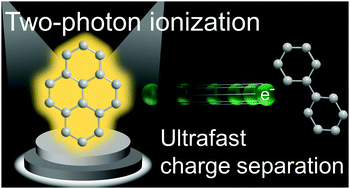Ultrafast capture of electrons ejected by photoionization leading to the formation of a charge-separated state at a high energy level†
Abstract
Electron transfer reactions driven by two-photon ionization in the higher excited state were investigated via transient absorption spectroscopy, with the aim to develop a method for creating the charge-separated (CS) state with a large formation rate, high energy level, and long lifetime. In the proof-in-principle experiments using pyrene and biphenyl as a model system, femtosecond transient absorption spectroscopy revealed that intense irradiation of an ultraviolet laser pulse at 355 nm efficiently pumps up pyrene into a higher excited state via a stepwise two-photon absorption, and then an ionization process takes place. An electron ejected from pyrene is directly captured by biphenyl with a time constant of 200 fs without the diffusion process of the electron in solution. The energy level of the CS state (Py+–Bp−) thus formed was estimated to be higher than that of the S1 state of pyrene by 0.53 eV. In addition, the subsequent ionic dissociation without a remarkable geminate recombination in the sub-nanosecond to nanosecond time region effectively avoids the quantity loss of the CS state. By applying the two-photon excitation method, we experimentally achieved ultrafast formation of the long-lived CS state at a high energy beyond the traditional framework of electron transfer reactions.



 Please wait while we load your content...
Please wait while we load your content...